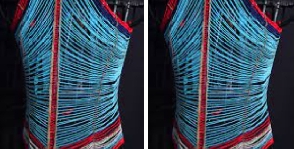 A replica corset/Photo credit: wikimedia Commons
A replica corset/Photo credit: wikimedia Commons
The Dinka people of South Sudan have been pastoralists for centuries – their possessions are often not tangibles like buildings and pieces of furniture, but, handy valuables they can carry along anytime they tend to their livestock. They prefer it to be wearable objects or items they can decorate their bodies with. One of the prized valuables in the Dinka customs is corsets.
The corset is made using a variety of materials, including leather and beads of various colors. These corsets are also crafted from glass beads, shells, ostrich eggshells, cow hide, metal, and ivory. One intriguing feature of the corset is the colors and patterns they take. Each element that goes into its weaving communicates a message, according to the learner. It can determine a person’s age, social standing, and level of prosperity. Aside from the decorative purpose of the corset, in the Dinka culture, it is a sign of many things. The corset is intricately beaded and serves as a form of body adornment.
For a Dinka man, it is his life’s garment, which is not worn beyond the rows of beads – that is the covering they rely on. For his entire life’s journey, what might change are the colors and rows, but the corset is the outfit he would wear either at home or on the field. The red and black rows which form the majority of the coloring of the corset, distinguish the difference between 15 and 25-year-old men.
The yellow beads found in the corset indicate the fact that the wearer may be over the age of thirty. The glass beads and wire used in making the corsets are imported products, making the outfits considerable markers of status and prestige. The vertical strip that runs on the spine represents the Dinka man’s wealth, and if the strip is higher than the shoulder, then it means he has a large herd of livestock.
The corset is primarily worn by elderly men as a symbol of their status and wisdom. The amount of beads on the corset indicates the age of the wearer, with more beads representing a higher age. It is also used as a way to differentiate between the younger and older men in the community, with only the elderly men being permitted to wear the corset.
It is believed that the wearing of corsets emerged among the people of Dinka in the 19th century after the arrival of the Turkish slavers from Cairo. The glass beads were imported from the Czech Republic for the slave trade with the Bari tribe, who are found on the banks of the White Nile.
With time, the Dinka people were impressed with the aesthetics as they controlled trade in the north of Juba and began incorporating it into their culture. It suffered extinction after the Islamist government of Sudan prohibited the use of corsets with the passing of Sharia in 1984, according to last places.